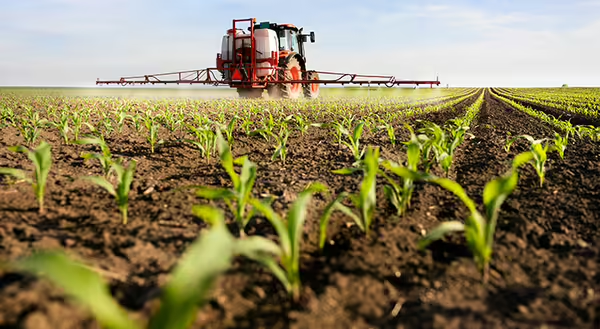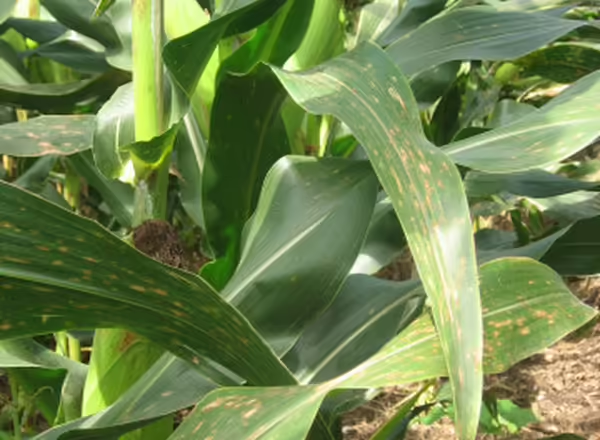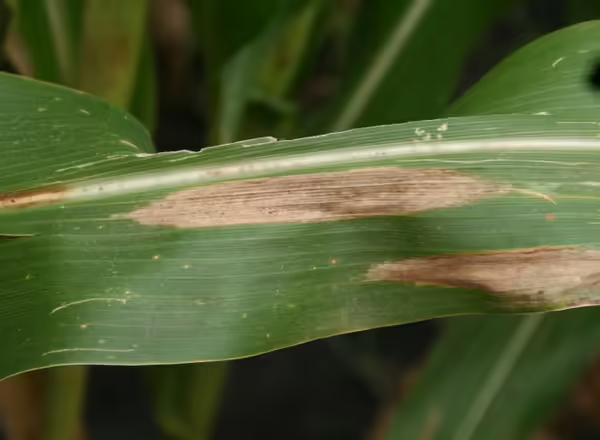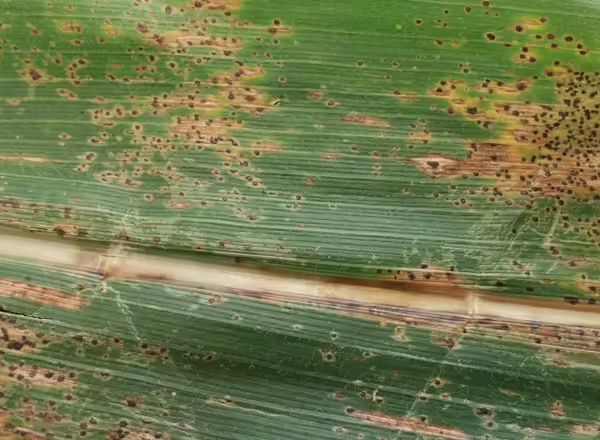
After a wet spring and early summer, corn and soybean fields across central Illinois are entering critical reproductive stages—and so is the risk of crop disease. While the plants may look healthy from the road, conditions are ripe for several fungal and soilborne pathogens to take hold, often before symptoms are visible. For farmers, this is the time when yield potential is at stake. For anyone connected to agriculture—whether you're in the field, advising growers, or simply following the season—understanding what’s happening below the canopy is key. This post highlights three common corn diseases to watch for right now, along with practical scouting tips to help you stay ahead of the curve. With timely action, there’s still a strong opportunity to protect your crop and your bottom line.
Grey Leaf Spot is caused by the fungus Cercospora zeae-maydis and has become more common in corn fields across Illinois and the Midwest in recent years. The first reported case was in Illinois in 1924, and it can be more prevalent in fields that are in continuous corn. The first symptoms will begin to appear on the lower leaves approximately two to three weeks before tasseling begins. The early signs may be difficult to identify since they are small pinpoint lesions with brown halos. However, as the season progresses, the lesions will become more rectangular and be grey or brown, parallel to leaf veins, and approximately 1.5 to 2 inches long. The fungus spores can overwinter in corn residue from previous growing seasons and spread to leaves from either wind or rain. Favorable conditions for infection include high temperatures (80°F or higher) and high humidity (90% or higher) for approximately 12 hours. When conditions are favorable, yield impacts can be severe. While no specific information on yield losses is available, the estimated loss from an infection can depend on how much of the leaf has lesions. If less than 5% of leaf area is infected, yield losses could be around 2%. In 25% to 75% of the leaf area is infected, yield loss could be between 5% to 20%. Crop rotation and tillage are effective practices to control the spread and infection and grey leaf spot, with some foliar fungicides being effective.
Northern Corn Leaf Blight is caused by the fungus Exserohilum turcicum. This fungus shares many of the same characteristics as Grey Leaf Spot. The fungus spores can overwinter on corn residue from previous years and spread by wind or rain. Infections will begin on the lower leaves and spread higher as the growing season progresses. Early signs of Northern Corn Leaf Blight are narrow and long tan lesions that are parallel to leaf veins. As time passes, the lesions will become larger and resemble cigars, appearing oblong with a brown/tan color. Favorable conditions for this fungus are extended wet periods (at least 6 hours) along with moderate temperatures (61-84°F). The impact on yields depends on when the lesions are present. If lesions are present on leaves next to developing ears approximately one to two weeks before and after tasseling, yields could be reduced up to 30%. Certain resistant hybrids and foliar fungicide applications are the most effective practices to combat Northern Corn Leaf Blight. Crop rotation can be effective, but different strands of the fungus (also called races) can make those options less effective.
Unlike Grey Leaf Spot and Northern Corn Leaf Blight, Tar Spot is a relatively new disease in the Midwest, first identified in Illinois and Indiana in 2015. Tar Spot is caused by the fungus Phyllachora maydis and can cause severe yield losses. The main symptom of Tar Spot are small, raised black lesions on a leaf that can also have a brown halo around them. Lesions with halos around them are known as “fisheyes” in Latin America. Tar Sport spores, like the other two fungi in this post, can overwinter in corn residue from previous growing seasons. The ideal conditions for Tar Spot are moderate temperatures (60-70°F) with high humidity (75% or greater) and prolonged leaf wetness (at least seven hours). Fields that are irrigated or close to river bottoms could be more susceptible to Tar Spot, given the relative humidity in those locations. So far this season, Tar Spot has been reported in the following counties: Bureau, Carroll, Grundy, Henry, Kendall, LaSalle, Livingston, Marshall, McDonough, Pike, Stark, and Warren. The impact on yields can be variable depending on the field and the severity of the infection. In some severe cases, yield losses can exceed 50 to 60 bushels per acre. Additionally, the spores cause reduced photosynthetic capacity, which can lead to lodging and decreased stalk integrity. When it comes to treating Tar Spot, foliar fungicides that are applied between the VT to R2 growth stages tend to be the most effective. Crop rotation and tillage can have minimal results, and there are no hybrid varieties that can combat Tar Spot.
As corn moves through its reproductive stages, the stakes are high—and so is the potential for disease to chip away at yield. Gray leaf spot, northern corn leaf blight, and tar spot are all active threats in central Illinois, especially following a wet start to the season. While symptoms may start small, these diseases can spread quickly under the right conditions. That’s why timely, boots-on-the-ground scouting is one of the most powerful tools you have. Walk your fields, check the canopy, and don’t wait for symptoms to reach the ear leaf before making a management decision. A well-timed fungicide application, guided by what you see in the field, can make all the difference in protecting your crop and your bottom line. If you suspect that a disease is present in your fields, the University of Illinois Plant Clinic can help! Collect a sample and send it in for analysis to know what you are fighting against. Visit their website at the link below to learn more about their services and how to submit a sample.
For additional information, visit the following links:
- University of Illinois Agronomy Handbook (2022)
- University of Illinois Plant Clinic
- Crop Protection Network Disease Forecasting
- Grey Leaf Spot
- Northern Corn Leaf Blight
- Tar Spot


